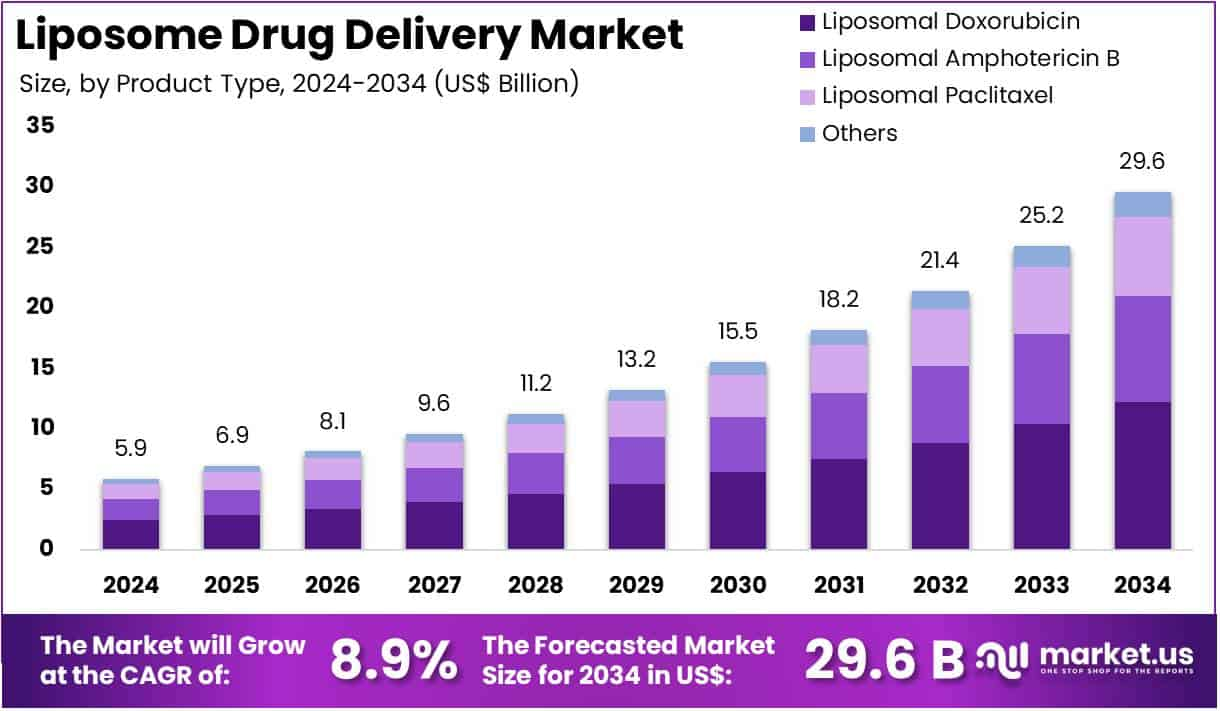Liposome Drug Delivery Market Ready for Big Leap Amid Rising Personalized Care Trends

The global Liposome Drug Delivery Market is projected to grow from USD 5.7 billion in 2024 to around USD 29.6 billion by 2034, expanding at a strong CAGR of 8.9%. This growth is driven by the increasing demand for targeted and safer drug delivery methods. Liposomes are small, fat-based vesicles that can transport drugs directly to affected tissues. This improves drug absorption and reduces side effects. Their ability to carry both hydrophilic and hydrophobic drugs makes them highly versatile. As chronic diseases become more common, pharmaceutical companies are turning to liposomes for more effective and long-lasting treatments.
One major factor fueling market growth is the global rise in cancer cases. According to the World Health Organization (WHO), cancer caused nearly 10 million deaths in 2020. Liposome-based chemotherapy drugs are preferred in many cancer treatments because they focus more precisely on tumor cells. This helps minimize harm to surrounding healthy tissue. The U.S. FDA has approved several liposomal formulations for cancer, including doxorubicin and cytarabine. These approvals have encouraged wider use of liposomal technology in oncology. As cancer cases continue to grow, so will the demand for liposome-based therapies.
Infectious and chronic diseases are also contributing to the market's rise. The U.S. Centers for Disease Control and Prevention (CDC) has reported an increase in resistant bacterial and viral infections. Liposomes help improve the delivery of antibiotics and antivirals, especially in patients with weakened immune systems. For chronic conditions like diabetes and cardiovascular disease, liposomes can release medication steadily over time. This makes treatment more consistent and less frequent. According to WHO, over 422 million people globally have diabetes, highlighting the need for improved delivery systems like liposomes.

Key Takeaways
- In 2024, the liposome drug delivery market reached US$ 5.7 billion and is projected to hit US$ 29.6 billion by 2034.
- The market is expanding at a compound annual growth rate (CAGR) of 8.9% during the 2025 to 2034 forecast period.
- Among product types, liposomal doxorubicin dominated in 2023, securing a strong market share of 41.3%.
- Other key product segments include liposomal amphotericin B, liposomal paclitaxel, and various other specialized liposomal formulations.
- In terms of technology, stealth liposome technology held the top position in 2023, accounting for 53.5% of total market share.
- Non-pegylated and depofoam liposome technologies are also gaining traction, but stealth variants remain the most widely used.
- Within applications, cancer therapy led the market by contributing a massive 49.4% share in the same year.
- Other key application areas include fungal diseases, pain management, viral vaccines, and photodynamic therapies.
- When segmented by liposome structure, unilamellar liposomes emerged as market leaders with a dominant 45.7% share.
- Large and small multilamellar liposomes also play vital roles, but unilamellar variants are most commonly preferred for targeted drug delivery.
GET SAMPLE REPORT : https://market.us/report/global-liposome-drug-delivery-market/request-sample/
Emerging Trends
1. Rise in Targeted Cancer Therapies
One major trend in liposome drug delivery is its growing use in cancer treatment. Liposomes are tiny bubbles that can carry chemotherapy drugs directly to tumors. This targeted approach reduces harm to healthy cells. As a result, patients experience fewer side effects compared to traditional chemotherapy. Many hospitals and clinics are now using liposomal drugs for treating solid tumors and blood cancers. Doctors prefer this method for its improved safety. It also increases the drug’s effectiveness. This shift is expected to grow as more cancer drugs are being reformulated with liposome technology for better delivery and patient outcomes.
2. Growing Focus on mRNA and Gene Therapy Delivery
Liposomes are becoming important in the delivery of mRNA and gene therapies. After the success of mRNA vaccines, researchers are exploring how lipid nanoparticles (a type of liposome) can treat other diseases. These include genetic disorders, rare conditions, and chronic illnesses. Liposomes can safely carry genetic material into cells. This makes them useful for delivering RNA or DNA directly to target tissues. Their role is expanding in clinical trials. Scientists believe that liposomes will play a key role in the future of personalized medicine. They offer a promising way to deliver new therapies without harming healthy tissues.
3. Use of Liposomes in Vaccines
Liposomes are gaining popularity as vaccine adjuvants. They help the body create a stronger immune response. In vaccines, liposomes carry antigens directly to immune cells. This method improves vaccine performance. After the COVID-19 pandemic, health experts began focusing more on advanced vaccine delivery systems. Liposomes became one of the top options. Their flexibility and safety make them ideal for modern vaccines. New research is ongoing to develop liposome-based vaccines for diseases like flu, HIV, and malaria. As the global demand for effective immunization grows, liposomes are set to play a larger role in the vaccine industry.
4. Improved Liposome Formulations for Longer Circulation
New liposome formulations are designed to stay longer in the bloodstream. One method uses polyethylene glycol (PEG) to coat liposomes. This "stealth" layer helps them avoid detection by the immune system. As a result, the drug inside the liposome circulates for a longer time. Patients benefit because they need fewer doses, and the treatment works more effectively. These PEGylated liposomes are being used in cancer therapy and other chronic conditions. Researchers continue to refine this technology to improve patient comfort and drug performance. Longer circulation means better results and reduced treatment burden for many patients worldwide.
5. Increased Demand for Non-Invasive Drug Delivery
There is a growing interest in non-invasive drug delivery methods. Many people dislike injections and prefer easier options. Liposomes are being studied for use in creams, nasal sprays, and inhalers. These formats are being tested for asthma, skin conditions, and neurological diseases. Liposome-based non-injectable treatments may help patients stick to their medications better. They also improve comfort, especially for those who need long-term therapy. Doctors and researchers are looking for more convenient ways to deliver drugs. Liposomes offer a safe and flexible way to deliver medication without the need for painful procedures.
6. Sustainable and Plant-Based Lipid Sources
Sustainability is becoming important in the liposome market. More companies now use plant-based or synthetic lipids instead of animal-derived ones. This change supports cleaner, more ethical production. It also helps manufacturers meet strict rules in different countries. Using plant-based ingredients makes liposome products more acceptable to global consumers. This trend is growing as people care more about what goes into their medicine. It also supports the shift toward green and cruelty-free healthcare practices. In the future, most liposome products may be made from sustainable sources. This change supports both human health and environmental goals.
Conclusion
In conclusion, the liposome drug delivery market is growing quickly due to its ability to deliver medicine safely and effectively. More companies and doctors are choosing liposomes because they target specific areas in the body and reduce side effects. Their use is increasing in cancer care, chronic diseases, and vaccine development. With better technology and a focus on non-invasive and sustainable methods, liposomes are becoming an important part of modern healthcare. As patient needs change and medical science advances, liposome-based treatments will continue to expand. This trend shows strong future potential, making the market an attractive space for innovation and investment in the coming years.
- Art
- Causes
- Crafts
- Dance
- Drinks
- Film
- Fitness
- Food
- Jogos
- Gardening
- Health
- Início
- Literature
- Music
- Networking
- Outro
- Party
- Religion
- Shopping
- Sports
- Theater
- Wellness


